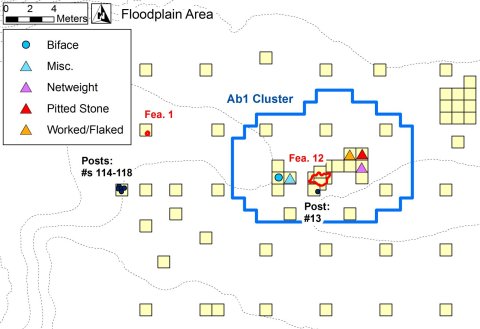Mapping material culture and features at the site allows us to see where activities were taking place during each period of site use at the Stratton Mill Creek site.
Cultural material was identified in the plow zone across the site in seven separate spatial clusters. The large, ring-shaped ditch is the focus of Cluster 1. Cluster 1 contained the largest chipped stone tool assemblage by both count and diversity of material culture. Archaeologists identified 32 post molds associated with the plow zone. All were in Cluster 1 on the terrace. The post molds probably represent areas of temporary shelters, windbreaks, or processing locations. They also may be associated with the large, ring-shaped feature. Most activities associated with the Ap horizon on the terrace were centered on this feature or areas adjacent to it (Cluster 1). A diversity of activities took place here, including hunting/butchering, stone tool production, plant processing, and to a lesser extent, fishing and wood working/other activities.

Four cultural components were identified on the floodplain portion of the site: two associated with the Late Archaic, one with the Transitional, and one with the Early Woodland. Of the two Late Archaic components, one was associated with the buried Ab3 horizon and the other with the Ab4 horizon. Two spatial clusters were identified for the Late Archaic, Ab4 horizon component. Few formal stone tools are present within either cluster. A hammerstone and a pitted stone (for nut processing) were present in Cluster 1. The stone tool and plant processing tool indicate that the main activities associated with Cluster 1 were stone tool making and plant processing. Butchering and drier hide processing also occurred. The possible smudge pit in Cluster 1 may have been used for hide processing. Only FCR was recovered from Cluster 2. The hearth in Cluster 2 suggests the need for light/heat and possibly food processing. Features appear to be a focal point of activity for both clusters.
The Ab3 horizon Late Archaic component also contained two locations of activity. Activities in Cluster 1 include plant processing and stone tool making, each represented by a single tool. While no features were associated with Cluster 2, the single feature identified in Cluster 1 is a hearth, indicating the need for heat/light and possibly food processing.
The Transitional component was associated with the buried Ab2 horizon. Two areas of activity were identified. For Cluster 1, stone tool making, plant processing, hunting/butchering, and fishing took place. Cluster 2 activities included stone tool manufacture. Both Transitional period features were located within a cluster (FCR concentration in Cluster 1 and hearth in Cluster 2). Activities centered on these thermal features. The FCR concentration in Cluster 1 could have been used for food preparation, while the hearth may have served the same purpose as well as being used for light and/or heat.
The Early Woodland component (Ab1 horizon) has one single clearly identified focus of activity. At this time, the site appears to have been used as a multi-task camp site centered on the large roasting platform which may have been used for food preparation. Activities likely focused on a variety of functional tasks, including: plant processing, stone tool making, fishing, and butchering and hide processing. Six post molds were also associated with the Early Woodland component. These posts likely represent areas of temporary shelters, windbreaks, or processing locations.
